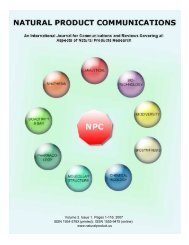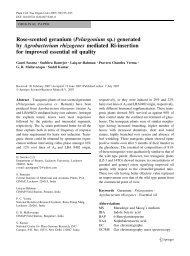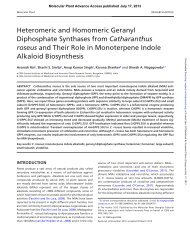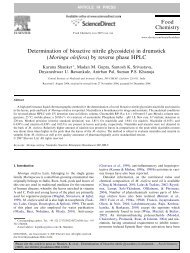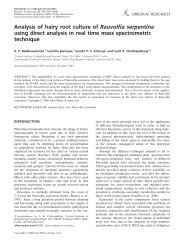Birendra Kumar*, SK Verma, G Ram,HP Singh. 2012 ... - CIMAP Staff
Birendra Kumar*, SK Verma, G Ram,HP Singh. 2012 ... - CIMAP Staff
Birendra Kumar*, SK Verma, G Ram,HP Singh. 2012 ... - CIMAP Staff
- No tags were found...
You also want an ePaper? Increase the reach of your titles
YUMPU automatically turns print PDFs into web optimized ePapers that Google loves.
798 B. Kumar et al.<br />
Downloaded by [<strong>Birendra</strong> Kumar] at 06:15 20 November <strong>2012</strong><br />
and PRC-1 but not Trishna and Vaishnavi (Table 2). Thus, the results indicated<br />
that the temperature of 25 ◦ C was optimum for Palmarosa seedling<br />
vigor index II, and temperatures beyond 25 ◦ C decreased seedling vigor<br />
index II.<br />
Perusal of Table 3 reveals that, in respect to the studied parameters,<br />
25 ◦ C was most conducive temperature for maximum germination percentage<br />
and high seedling vigor as indicated by index I and II. Hence, 25 ◦ C<br />
can be concluded as the optimum, but no definite pattern could be established<br />
regarding other temperatures under consideration. While 20 ◦ Cwas<br />
the second best temperature with respect to germination percentage with<br />
one exception of variety Vaishnavi, 30 ◦ C was the second best temperature<br />
for seedling vigor index I. The trend regarding seedling vigor index II was<br />
not decisive; the temperature of 30 ◦ C was found second best for PRC-1 and<br />
Tripta and 35 ◦ C for Trishna and Vaishnavi (Table 3).<br />
Both seedling vigor indices are a measure of seedling growth. Vigor<br />
index I considers seedling length, which is quickly measured using a ruler<br />
in the laboratory situation. Vigor index II considers seedling mass, which<br />
requires that seedlings be weighed after they are dried in an oven. Thus,<br />
in most seed laboratories, vigor index I is used more frequently than vigor<br />
index II because it is faster. Our results showed that the same information<br />
relative to the optimum temperature conditions for seedling growth could<br />
be obtained with both indices. However, since seedling mass is probably a<br />
better indication of seedling health than seedling length (i.e., in poor light,<br />
seedlings might be etiolated), we suggest that more accurate information<br />
about the potential for early seedling growth of varieties could be obtained<br />
by using vigor index II than vigor index I.<br />
Because the seedling vigor index is indicative of the survival potential<br />
and health of Palmarosa seedlings, information about the effects of temperature<br />
on early growth of seedlings should allow growers to manage conditions<br />
for optimal growth of each variety. For example, although 25 ◦ C is the best<br />
for germination and early seedling growth of a variety, if this temperature is<br />
not available it would be better to use 20 ◦ C for some varieties and 30 ◦ Cfor<br />
others (Table 3). The decision of which temperature is best would depend<br />
on the variety. Thus, if 25 ◦ C were not continuously available, it probably<br />
would be better to have a situation where the temperature is lower<br />
(20 ◦ C) during germination and then increases during the early growth of the<br />
seedlings.<br />
The variable seedling vigor index may be attributed to the genetic<br />
constitution of individual varieties (Sharma 2000). Harvesting the seed<br />
before attainment of physiological maturity also could decrease viability<br />
and vigor potential because of a large number of immature seeds with<br />
poor embryo development and high moisture content as reported in Lens<br />
culinaris (Khatun, Kabir, & Bhuiyan 2009) and Pisum sativum (Matthews<br />
1973).




